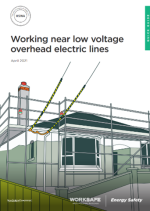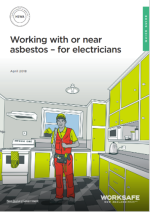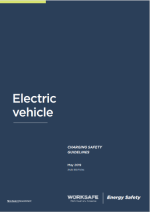Electron Issue 118
Keeping you up to date with the latest regulatory changes, exam reports, technical issues, consultation results and other issues affecting electrical workers - published February 2023.
Presiding Member's update

Kia ora koutou
Welcome to the New Year 2023. I hope you all had a safe, relaxing Christmas Break and are looking forward to a busy, productive year ahead.
The Board members are looking forward to the Regional Meet and Greet Programme as we are able to engage with electricians face to face. It is an opportunity for you to ask the Board all those burning questions, so if you can, please come and meet with your Board members.
There are signals from the Government and industry that 2023 is going to be a difficult year in the construction industry and associated trades. Please remember, however, you cannot withhold certification documents if you are having a dispute with owners or main contractors. Complete and prompt certification is a requirement of the regulations so please make sure the paperwork is done.
Finally, there are still vacancies on the Board. If you are interested in becoming a Board Member, please check out the EWRB website for more information and please apply.
Mel Orange
Presiding Member
Registrar update

Kia ora koutou
Welcome to the 118th issue, and the first edition of Electron newsletter for 2023.
I hope many of you managed to spend some relaxing time over the summer with whānau and friends, refreshing yourself for what will no doubt be another busy year ahead. For those of you who worked through, I hope you have a decent break planned in the coming months.
In this newsletter, we have an important article on the MATES programme available to you as workers in the construction industry. If you or someone you know in the industry is struggling or needs help, call 0800 111 315. You can find out more about the MATES programme on their website.
mates.net.nz(external link) — Mates in construction
Take care, work safely, and thank you for taking the time to read this edition of Electron.
If you have any comments or suggestions for future Electron editions, please let me know by emailing Registrations@ewrb.govt.nz
Duncan Connor
Registrar of Electrical Workers
Standards of the Month AS/NZS 4836 and NZECP 34:2001
AS/NZS 4836
AS/NZS 4836:2011 Safe working on or near low-voltage electrical installations and equipment provides a minimum set of procedures, safety requirements and recommendations for a safe working environment on or near electrical installations or systems. Guidance helps to manage hazards including arc blast, arc flash, electric shock and electrocution.
This edition – the current and latest – contains information on risk management, assessment and treatment, working with asbestos and PCBs, working below ground level, cutting cables and working enclosures, selection and use of test equipment and PPE and preservation of an incident scene.
It is the responsibility of all persons to ensure that the work they are doing does not present a risk to themselves or others at the worksite or at a remote location. Adhering to standards like AS/NZS 4836 ensures you are not just compliant but get home safe.
AS/NZS 4836 is available through EWRB’s online subscription to standards through Standards New Zealand and features in EWRB’s top 20 standards downloaded. An important standard, it is cited in WorkSafe New Zealand: Energy Safety’s Electricity (Safety) Regulations 2010 (Schedule 2 and 100(1)(d)). AS/NZS 4836 was developed jointly between Australian and New Zealand representatives covering user and sector industry bodies and associations, government and regulation, installation and contractors and health and safety.
NZECP 34:2001
This Electrical Code of Practice (Code) sets minimum safe electrical distance requirements for overhead electric line installations and other works associated with the supply of electricity from generating stations to end users.
The minimum safe distances have been set primarily to protect persons, property, vehicles and mobile plant from harm or damage from electrical hazards. The minimum distances are also a guide for the design of electrical works within substations, generating stations or similar areas where electrical equipment and fittings have to be operated and maintained.
The Code has been designed to include, in its various sections, requirements that were previously contained in the Electricity Regulations 1997 (the Regulations). Compliance with this Code is mandatory.
This Code, among others, is available on the WorkSafe website.
Electrical codes of practice(external link) – WorkSafe New Zealand
Guidelines
Electrical workers (EW) are reminded that in addition to the Regulations and Standards, there are several guides that have been produced by WorkSafe. While these published guides might not be cited by the Regulations, they nevertheless represent “Reasonably Practicable Steps” that may be used to support safe and compliant workplace practices.
Guide to working close to electric lines.
 At a time of year when a significant amount of home maintenance is being carried out, this guide is particularly relevant and highlights a service or advice that an EW can provide to homeowners or professionals carrying out maintenance work near overhead lines, including those supplying garages and sheds. This guide provides information on how to manage the risk of electric shock while work is being done near a live low voltage overhead electric line.
At a time of year when a significant amount of home maintenance is being carried out, this guide is particularly relevant and highlights a service or advice that an EW can provide to homeowners or professionals carrying out maintenance work near overhead lines, including those supplying garages and sheds. This guide provides information on how to manage the risk of electric shock while work is being done near a live low voltage overhead electric line.
Working near low voltage overhead electric lines(external link) — WorkSafe New Zealand
To maintain safety when electrical work is being carried out the requirements of standard AS/NZS 4836 need to be applied. It is also important to be familiar with and follow the obligations and responsibilities under Part 8 (Working Practices) of the Electricity (Safety) Regulations 2010.
Part 8 (Working Practices) of the Electricity (Safety) Regulations 2010(external link) — New Zealand Legislation
Guide to working with or near asbestos
 Most cases of asbestos-related diseases are caused by exposure to airborne asbestos fibres in the workplace. Electrical workers are in one of the trades where they are most at risk from being likely to encounter and disturb asbestos during their work.
Most cases of asbestos-related diseases are caused by exposure to airborne asbestos fibres in the workplace. Electrical workers are in one of the trades where they are most at risk from being likely to encounter and disturb asbestos during their work.
It is, therefore, important for employers and workers to identify locations where asbestos may be encountered to protect themselves and the public from accidental exposure.
This guide provides information to assist in identifying areas where asbestos is likely to be found and how to manage the associated risks.
Asbestos Quick Guides for tradespeople(external link) — WorkSafe New Zealand
Working with or near asbestos - for electricians [PDF, 829KB](external link) — WorkSafe New Zealand
Guides to Electric Vehicle (EV) charging
 There are two publications related to EV charging. They are available from the WorkSafe Website
There are two publications related to EV charging. They are available from the WorkSafe Website
- Electric vehicle charging safety guidelines - 2nd edition
- Addendum to the Electric vehicle charging safety guidelines - 2nd edition (The addendum is where the use of an RDC-DD and type A RCD is provided for)
Guidelines for safe electric vehicle charging(external link) — WorkSafe New Zealand
Important guidance to EV charging
- When additions are made to an installation, the new work must not adversely affect the safety of the existing installation or its fittings. This vital requirement is mandated in Regulation 66 of the Electricity (Safety) Regulations 2010.
Regulation 66 of the Electricity (Safety) Regulations 2010(external link) — New Zealand Legislation - For Mode 3 and 4 chargers, it is essential to assess the maximum demand of the installation and verify that the mains, final subcircuit ratings and volt drops are compliant.
- It is also important to understand that an EV charger is a safety device and must be rated for the standard NZ supply voltage.
- It is strongly recommended that an earth fault loop impedance test is carried out to verify the adequacy of the mains and charger final subcircuit.
- A reminder that EV chargers for public use are subject to periodic verification to affirm they remain electrically safe and compliant.
Tiny Houses (Imported prefabricated electrical installations)
In NZ, there is an increasing interest in importing prefabricated (fully assembled, kitset, flatpack) structures such ‘tiny houses’ container homes, kiosks, sleep-outs, cabins which may be partially or fully wired and fitted out as an electrical installation.
A guide to the NZ requirements for the construction, certification and connection for these types of imported structures is in the final stages of production and will be available on the WorkSafe -EnergySafety website shortly.
This guide will provide importers, sellers and EW information to assist with conforming to the requirements of the Electricity (Safety) Regulations 2010.
MATES in Construction - Back on site with MATES
The MATES programme became operational in New Zealand in late 2019 and was introduced to reduce the high levels of suicide among construction workers. The research-based programme does this by raising awareness, building strength on construction sites, and connecting people to appropriate support.
The construction industry loses more workers to suicide every year than any other industry in New Zealand. On average, one construction worker takes their own life every week.
As the industry settles into 2023, it is time to get moving after a well-deserved break. The second week of January saw our MATES Field Officers out and about welcoming MATES back to sites around the country, reminding our people of the importance of taking time to talk about mental health and checking in with our mates.
While the boots go back on, the batteries are charged and the tools are running, some of our mates might need a little extra support to get going again.
For many, the holiday period can be a challenging time and returning to work comes with its own pressures. Financial stress is often on the minds of many; the additional uncertainty of rising inflation (currently at a 30-year high) and cost of living increases have impacted many of us.
Alongside long hours and ever changing work environments, the new year will bring fresh challenges to the mental health and wellbeing of those integral to our diverse industry.
At the end of 2022, MATES spoke with one of our valued investment partners who shared with us some of these challenges and the impact that MATES was able to have on his sites:
“There’s no such thing as a 40-hour week. It’s 50 or more now. The other day I left home at six o’clock in the morning and I got home about 10 past six at night. In the construction industry I see people’s lives dominated by work, so, anything that can provide that balance helps.
When I did the MATES ASIST course, I was on a project where we got accreditation and we ended up using those skills on the site to support someone in crisis. One of the connectors was concerned about one of the guys, and so gave MATES a call. MATES came, grabbed the guy off site and got him the help that he needed. That was fantastic.
It helps people realise that everyone has the same worries and puts us all on the same wavelength. It gives you companionship, knowing that other guys on site are willing to actually help, and that anxiety or depression are normal parts of our lives.
It makes you smile when you go past a site and see that MATES flag flying - and it might not even be the same company as yours. But you know that on that job they are there to support their workers.”
Last year alone MATES delivered 1472 trainings across the board to over 27,500 people in our industry.
“I am so proud of our team, our volunteers and our investment partners who have come together to do this important mahi. I am also excited to see us take this momentum and passion into the next year.
The work doesn’t stop here. Looking ahead we are all working together on our list of priorities which will build on the year’s successes. The key goal is to achieve sustainable long-term funding and secure more leadership from government agencies to demonstrate that mental health, wellbeing, and suicide prevention aren’t just an add-on, but an integral part of what they do.” – Victoria McArthur, CEO MATES in Construction
If you or someone you know in the industry is struggling or needs help, call 0800 111 315.
Interested in helping MATES deliver our programme to more sites? Find out more about becoming a partner, fundraising or donating on our website
mates.net.nz(external link) — Mates in construction
Disciplinary Hearings
The Board often hears cases involving prescribed electrical work that has been livened and certified but is not compliant because an expected or anticipated future event has not occurred.
An example of this is the first case reported below. A mains cable was installed with the expectation that it would be concreted over. That did not occur, and, as a result, the cable was buried too shallowly.
Prosecution
EWRB v Ian Leslie Johnston
Mr Ian Leslie Johnston was sentenced in the New Plymouth District Court on one charge of illegally performing prescribed electrical work.


